The Huawei Honor 8 Review
by Matt Humrick on October 13, 2016 8:00 AM EST- Posted in
- Huawei
- Smartphones
- Mobile
- Kirin 950
- honor
Battery Life
The Honor 8 uses the same 3000 mAh (11.46 Wh) battery as the Huawei P9, which is an average size for phones with roughly 5-inch screens. For example, the Samsung Galaxy S7, whose 5.1-inch SAMOLED display is almost the same size as the Honor 8’s, has a similar 3000mAh (11.55 WHr) battery.
In our initial look at the HiSilicon Kirin 950 in the Mate 8 review, we were surprised by the SoC’s efficiency. Manufactured on TSMC’s 16nm FinFET+ process, its A72 CPU cores deliver almost twice the performance per watt of the A57 cores in Samsung’s Exynos 7420 at its maximum operating point. Part of this difference comes from the redesigned A72 core—ARM optimized nearly every block to reduce power consumption—while another chunk comes from HiSilicon’s efforts. The Kirin 950 is one of the better implementations of ARM IP we’ve seen.
To see how the Kirin 950 impacts the Honor 8’s battery life, we’ll run it through our standard suite of battery tests. To make the tests accurate and repeatable, we control as many variables as possible, including minimizing background tasks and calibrating each display to 200 nits at 100% APL.
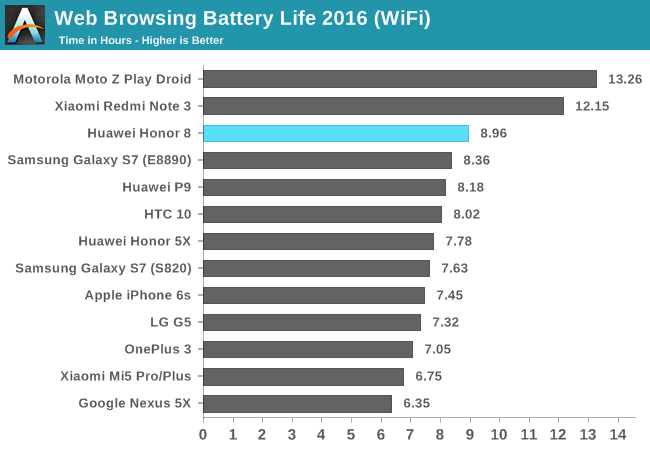
The phone’s display is still the primary power consumer in our browsing tests, but the CPU gets involved too by loading and scrolling through a set of popular pages. In the Wi-Fi browsing test, the Honor 8 lasts almost 9 hours, around 2 hours longer than the OnePlus 3 and Xiaomi Mi 5.
| Web Browsing Battery Life 2016 (WiFi): Average Platform Power (APP) | ||
| Phone | Display | APP (W) |
| Huawei Honor 8 | 5.2-inch 1080p IPS LCD | 1.28 |
| Xiaomi Redmi Note 3 | 5.5-inch 1080p IPS LCD | 1.28 |
| Galaxy S7 (E8890) | 5.1-inch 1440p SAMOLED | 1.38 |
| Huawei P9 | 5.2-inch 1080p IPS LCD | 1.40 |
| HTC 10 | 5.2-inch 1440p IPS LCD | 1.44 |
| Galaxy S7 (S820) | 5.1-inch 1440p SAMOLED | 1.51 |
| OnePlus 3 | 5.5-inch 1080p AMOLED | 1.62 |
| Xiaomi Mi5 Pro | 5.15-inch 1080p IPS LCD | 1.72 |
The average platform power (APP) figures in the table above are a rough estimate of each phone’s average power consumption, extrapolated from total runtime and battery capacity, and are not measured quantities. These values are just a different way of visualizing the data in the chart after normalizing for battery size.
We can see the Honor 8 does quite well in this test, generally consuming less power than the phones using the Snapdragon 820 SoC. There’s some variation due to display size and type, but the Honor 8 averages between 11% less than the HTC 10 and and 26% less than the Xiaomi Mi5 Pro.
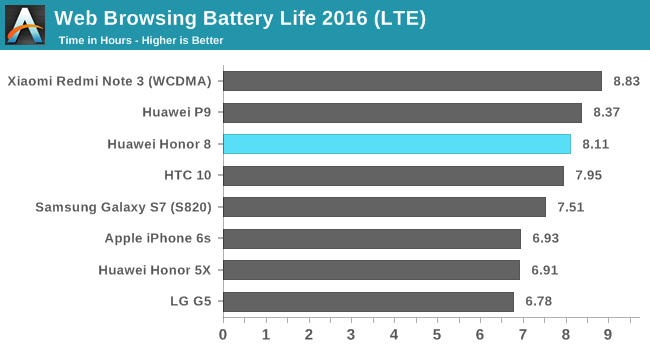
Switching over to the LTE radio, the Honor 8 still manages to last just over 8 hours, only about a 9% drop relative to using Wi-Fi. The HTC 10 and Galaxy S7 with Snapdragon 820 show even less change in total power consumption, allowing them to close the gap with the Honor 8. The Huawei P9 actually lasts 2% longer in the LTE test, jumping over the Honor 8, but the difference is small enough that it falls within the error level of these tests.
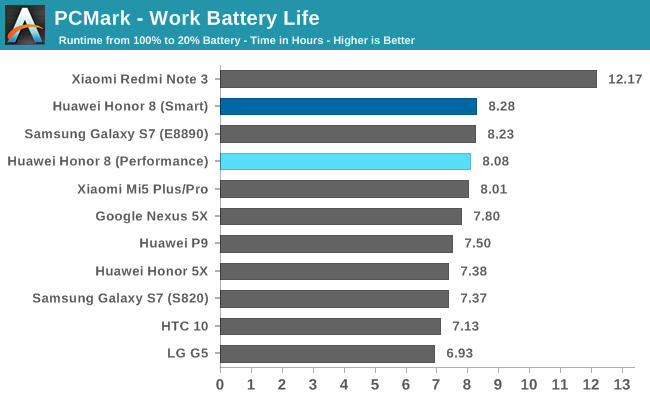
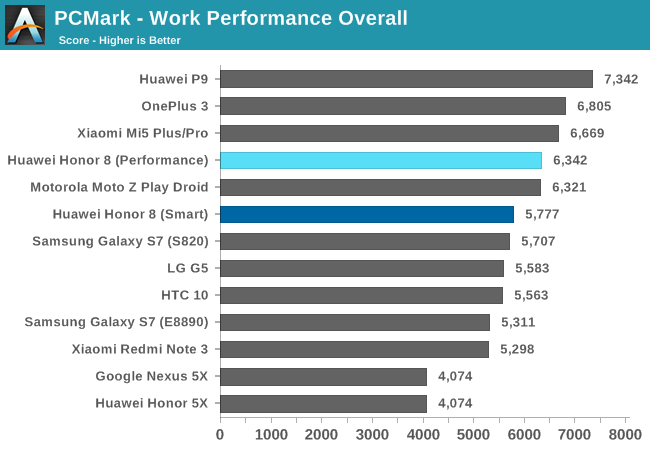
The Honor 8 is no match for the Redmi Note 3 and its big battery in PCMark, but it still lasts more than 8 hours, placing it among the best flagship phones. It manages this feat while still delivering very good performance too. With 8 hours of screen on time while running a continuous workload, the Honor 8 should have no problem lasting a full day on a single charge for most people.
The Honor 8 does manage to last a few minutes longer using its Smart battery mode, but the difference relative to the Performance mode is negligible. This is not all that surprising considering that the Smart mode seems to primarily affect the target frequency for the lower-power A53 cores, dropping it from 1.5GHz to 1.3GHz in moderate workloads. This small power savings is overshadowed by the display, but its 9% impact on overall performance is easier to see. There does not seem to be much advantage to using the Smart mode, at least not for the types of workloads used by PCMark.
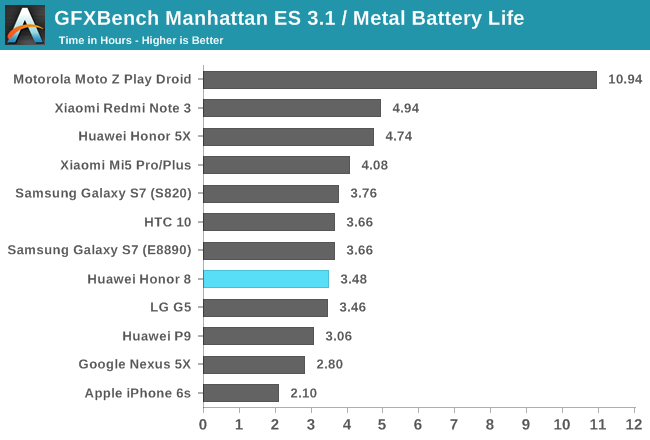
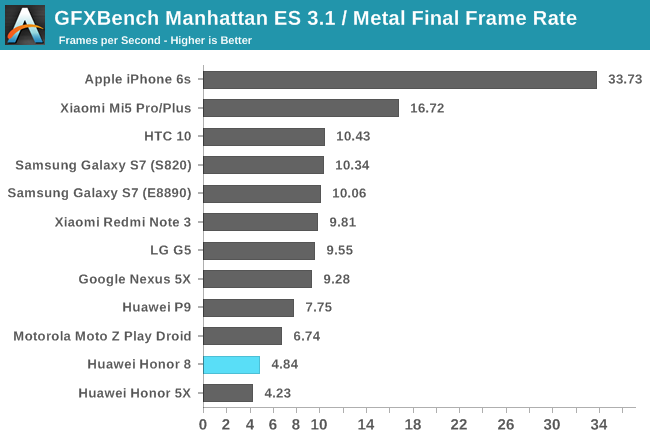
In the GFXBench Manhattan 3.1 battery life test, which predicts runtime while playing games, the Honor 8 lasts 3.5 hours, an average result that turns disappointing when you factor in performance. The LG G5, for example, lasts just as long but delivers 38% better peak onscreen performance, which extends to almost 100% by the end of the test. Granted, the G5 is a more-expensive phone, but even the Xiaomi Redmi Note 3 Pro, which is around half the Honor 8’s price, lasts 42% longer, with the help of its large battery, and while the Honor 8’s peak performance is 16% better, its sustained performance is less, with a final frame rate almost half of the Redmi’s value.
The Honor 8 is able to maintain peak gaming performance for 42 minutes in GFXBench Manhattan 3.1 before it’s forced to reduce GPU frequency to avoid overheating. Frame rate then oscillates wildly between 8-11fps until a series of forced battery saving steps kick in, which cannot be disabled. The first step occurs at the 2.4 hour mark when the battery level hits 30%, reducing frame rate to 8-9fps. The next step occurs just past the 3 hour mark when the battery level hits 10%, with the final step occurring at 3.3 hours with only 4% charge left, dropping performance to 4.8fps.
I’ve also included the P9’s performance stability graph for comparison. It starts throttling GPU frequency only 22 minutes into the test, so the Honor 8 maintains near peak performance for nearly twice as long. The P9’s performance is much more stable, however, avoiding the Honor 8’s big oscillations. It still goes through the same series of steps where it reduces GPU frequency to save battery power. The step with 30% charge remaining is not really noticeable because performance is already in the 9fps range. When the battery level hits 10% 2.9 hours in, it reduces performance to the same 6.4fps level as the Honor 8, and then down to 4.8fps with 4% charge left at the 3.1 hour mark.
Battery Charging
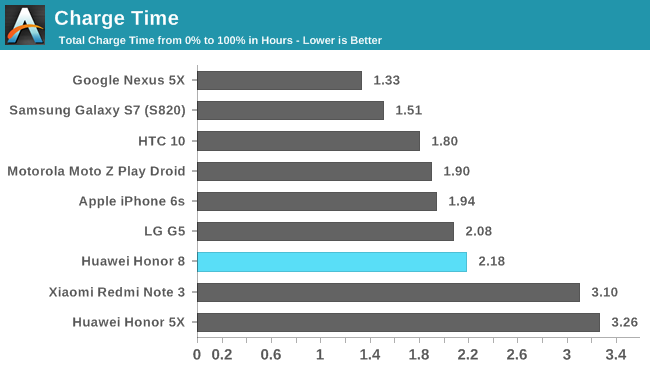
The Honor 8 includes a fast-charging system that incorporates Texas Instruments’ MaxCharge components, including the BQ25892 battery charger IC that implements battery temperature monitoring and overvoltage/overcurrent protections. The included wall charger is rated for 5V or 9V operation at 2A for a theoretical maximum of 18W at the wall and about 12W at the battery.
The Honor 8 oscillates between 8.5-12W for the first 37 minutes of charging. It then holds at a fairly constant 8.5W for another 20 minutes before tapering off quickly into a trickle charge. This charges the battery to 25% in 15 minutes and to 50% in 32 minutes. It reaches a full charge in 2.2 hours. As a side note, Huawei claims the Honor 8 reaches 47% charge in 30 minutes, which is exactly what I measured. It still does not charge as quickly as the Galaxy S7 or some other phones, but it still charges plenty fast.


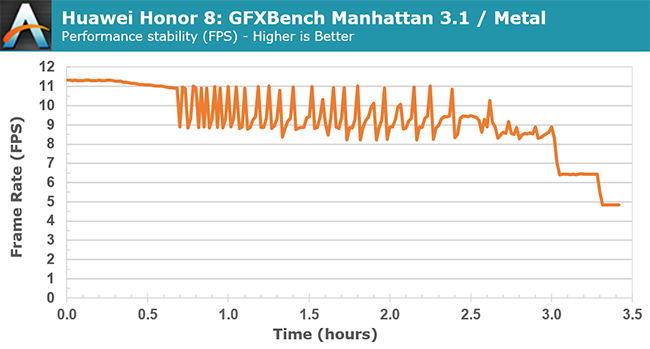
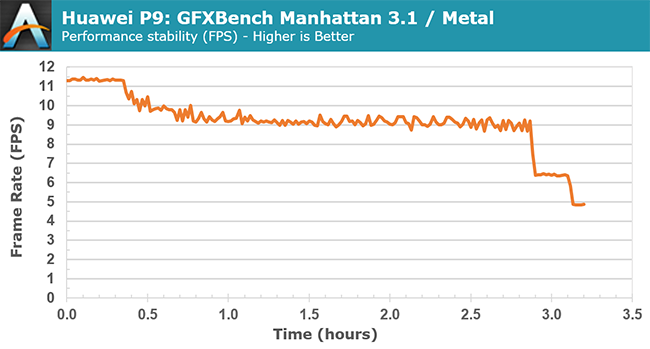
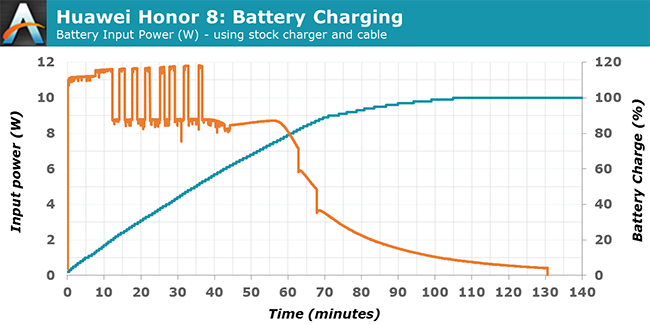








95 Comments
View All Comments
Matt Humrick - Friday, October 14, 2016 - link
That's a good point. The Smart mode selectively reduces screen brightness when using specific apps. It does not alter screen brightness for the PCMark test, which is one reason why there is not a bigger gap between it and the Performance mode; however, it does drop brightness from the calibrated 200 nits to about 100 nits when using the Chrome browser, which would increase the battery life in our web browsing battery life tests (these were run in Performance mode).prku - Friday, October 14, 2016 - link
Honor 8 is not a dual-standby dual sim phone. Please check again. it is supposed to have Dual Sim Full Active (which is a major selling point). DSFA is supposed to be present in all but Indian variations of the Honor.randomlm - Saturday, October 15, 2016 - link
Thanks for the nicely written, well balanced and non-biased review matt. This is the standard I've come to expect from anandtech that imo, some other reviewer on this site hasn't been delivering, especially on the camera portion of the review.Of course, entirely just my opinion
Feegenie - Saturday, October 15, 2016 - link
Fair.........jvl - Saturday, October 15, 2016 - link
"It’s a bit unfair to point our fingers solely at the OEMs and carriers, of course, because it was Google that created this mess and, ultimately, only Google can clean it up."What.
lagittaja - Saturday, October 29, 2016 - link
Do you even Android? Version distribution. Google can't force OEM's or carriers to update the devices.Even Android N's "auto update" doesn't really fix anything.
Why would the carrier or OEM keep updating the devices if they can just drag their feet on the ground making the update process as slow and painful as possible or just flat out not update them? Even once? The consumer will just buy a new device anyway.
Between 29th Aug and 5th Sept, of all the devices "phoning home" to Google a whopping 81.3% were running Android Lollipop 5.1 or older version.
If you take Lollipop out of the equation, 46.3% of the devices were running KitKat 4.4 or older.
If you take KitKat out of the equation, still almost 20% of the devices were running Jelly Bean 4.3 or older..
https://developer.android.com/about/dashboards/ind...
http://www.infoworld.com/article/3072591/android/g...
Google even tried to downplay the issue during May I/O event saying "it's not fragmented".
https://data.apteligent.com/download-report?report...
Yeah, that looks SO much better... 80%+ of devices being used are running Lollipop or older. A third of the devices being used are running KitKat or older..
And saying yeah, well only KitKat, Lollipop and Marshmallow matter because reasons and hey look at that 92% of devices being "used" are running Android OS's that "matter" and oh hey in contrast to iOS there's only iOS8 and iOS9 that matter and oh hey that comprises 97% of the iOS traffic. We're just as good as Apple! Yey us!
Uhm no.. Apple keeps it tidy because they have CONTROL...
iOS 9 only runs on devices that are from 2011 or older.
iOS 10 only runs on devices that are from 2012 or older.
Google has no control what so ever of Android devices that are not made by them.
Bloody hell, there's still Android devices sold new that run KitKat. And guess what, most of them are not going to receive a single damng update because the OEM doesn't give a flying fuck about it.
Look at Apple, look at what devices they sell. Guess what, they run iOS 10 or are just waiting to be turned on so they can nag you that there's a pending update.
With Android Nougat Google should have grabbed the "bull by the horns" and just fix the God damn problem.
They should have made a way for them to be able to at least deliver the critical security updates to the devices "automagically" no matter what sort of customizations OEM's or carriers have done.
I don't have the faintest idea of how that could be done but it's the least that needs to be done.
P.S. I'm an Android user and always will be. I don't like Apple's devices or their OS but I like how good control they have over their devices.
phuzi0n - Sunday, October 16, 2016 - link
Is this a phone review or a car review? We could do without all the car analogies in the first three paragraphs.Badelhas - Sunday, October 16, 2016 - link
I hate these Chinese UI skins which are iPhone iOS imitations. But that's just me.nkuehn - Friday, October 21, 2016 - link
Matt, did you also do testing on the Cellular Performance? Anandtech is famously good at really testing and not just testin, but I'm totally missing this part. I'm asking because some other reviewers had serious issues with the LTE performance of the device, losing LTE connection in well covered area etc.Maybe partner with people like http://cellularinsights.com/ - they have the testing hardware for cell that you have for displays and all the other stuff.
Savanah - Thursday, October 27, 2016 - link
I am so glad I went for the Moto Z Play instead of the Oneplus 3. It has a premium build quality, great display, awesome battery life, buttery smooth performance and decent cameras. It also excels in areas we tend to take for granted like call quality and signal retention. And to top it off it is bound to get fastest Android updates of any non Nexus/Pixel device. What else can you wish for in a $350 smart phone?